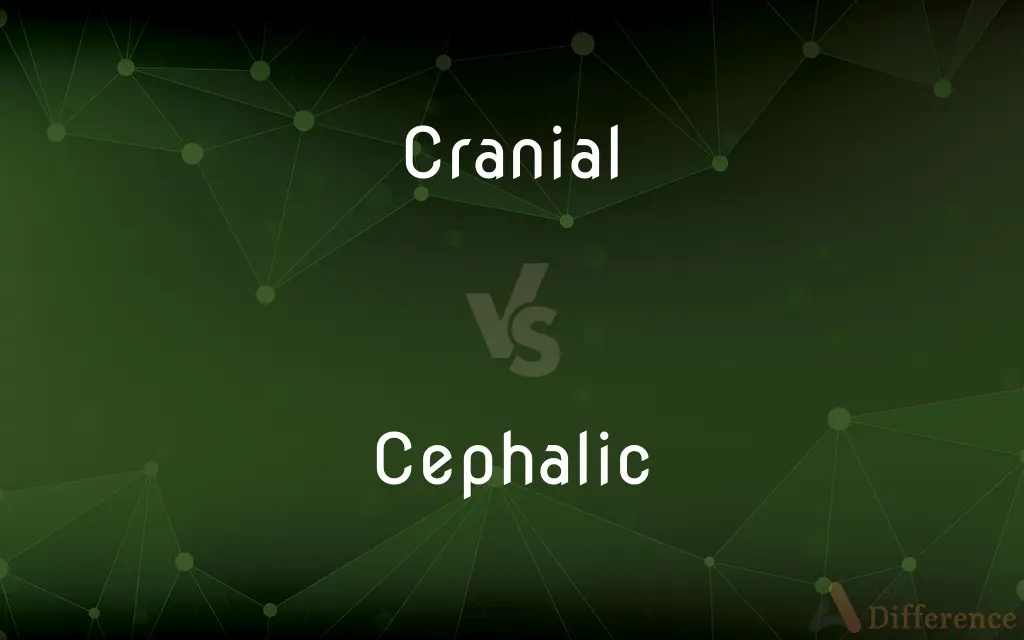Cranial vs. Cephalic — What's the Difference?
By Urooj Arif & Fiza Rafique — Updated on April 24, 2024
Cranial pertains specifically to the skull, emphasizing its structure and contents, while cephalic refers broadly to the head, including its external and internal features.

Difference Between Cranial and Cephalic
Table of Contents
ADVERTISEMENT
Key Differences
Cranial is a term used primarily in anatomy and medicine to describe aspects specifically related to the skull, such as cranial nerves or cranial bones. It focuses on the structural and protective components of the skull that house the brain. Whereas, cephalic is a broader term that refers to the head as a whole, including both internal structures like the brain and external features such as the face and scalp.
In medical contexts, "cranial" is often used when discussing injuries, surgeries, or diagnostic studies that involve the skull. It highlights the anatomical specificity required in such contexts, dealing directly with the bony structure and its immediate contents. On the other hand, "cephalic" can be used in a wider range of biological and medical discussions, often relating to the orientation or directional terms in anatomy, as in "cephalic end" of an embryo, which indicates the head end.
Cranial examinations typically focus on the bones of the skull, the brain, and other internal elements protected by the cranial cavity. These examinations are crucial in neurology and neurosurgery. Conversely, cephalic examinations might consider aspects like facial symmetry, skin conditions, and sensory organ function, covering a more extensive range of head-related medical concerns.
In descriptive anatomy, "cranial" is used to denote direction towards the skull or within the skull, as in cranial pressure or cranial nerves that emerge directly from the brain. Whereas, "cephalic" might be used more generally to describe anything located toward or at the head of an organism, often used interchangeably with terms like "superior" in human anatomy.
While "cranial" is often associated with deeper, more specific clinical and anatomical discussions, "cephalic" can appear in more general medical and popular discussions, making it a more commonly encountered term outside specialized medical fields.
ADVERTISEMENT
Comparison Chart
Definition
Pertaining to the skull.
Pertaining to the head.
Focus
Primarily the skull and its contents.
Broadly the entire head.
Medical Usage
Used in neurology and cranial studies.
Used in general head-related medical terms.
Directional Usage
Indicates direction towards or within the skull.
Refers to the head end or upper part of a structure.
Common Contexts of Usage
Neurosurgery, cranial injuries.
General physical examinations, describing head orientation.
Compare with Definitions
Cranial
Pertaining to the upper part of the skull.
Cranial sutures are joints between the bones of the skull.
Cephalic
Used to describe the orientation towards the head end in anatomy.
In fetal development, the cephalic end develops first.
Cranial
Concerning the position within or towards the skull.
Cranial pressure can indicate swelling or injury to the brain.
Cephalic
Broadly used in medicine to describe head-related issues.
Cephalic pain can be symptomatic of a variety of conditions.
Cranial
Involving the cranial nerves that emanate from the brain.
Cranial nerve damage can affect sensory and motor functions.
Cephalic
Concerning medical treatments or conditions affecting the head.
Cephalic disorders may involve neurodevelopmental issues.
Cranial
Used in context of surgeries or treatments involving the skull.
Cranial surgery requires precise navigation around critical nerves and vessels.
Cephalic
Descriptive of features located on or near the head.
Cephalic fins on some fish species are near the head.
Cranial
Relating to the skull or cranium.
The cranial cavity protects the brain with its rigid bone structure.
Cephalic
Relating to the head or pertaining to the head.
Cephalic phase of digestion begins with the sight and smell of food.
Cranial
Of or relating to the skull or cranium.
Cephalic
In or relating to the head.
Cranial
(anatomy) Of or relating to the cranium, or to the skull.
Cephalic
Of or relating to the head.
Cranial
(anatomy) cephalic.
Cephalic
Located on, in, or near the head.
Cranial
Of or pertaining to the cranium.
Cephalic
Of or relating to the head.
Cranial
Of or relating to the cranium which encloses the brain;
Cranial pressure
Cephalic
Of or relating to the brain.
Cephalic
Of or relating to the cephalon (the head of a trilobite).
Cephalic
Toward the head; in bipeds such as humans, this direction corresponds to superior.
Cephalic
Headlike; cephaloid.
Cephalic
Of or pertaining to the head. See the Note under Anterior.
Cephalic
A medicine for headache, or other disorder in the head.
Cephalic
Of or relating to the head
Common Curiosities
Are cranial and cephalic interchangeable terms?
While they both relate to the head, cranial and cephalic are not completely interchangeable; cranial is more specific to the skull, whereas cephalic encompasses the entire head.
What does cranial typically refer to in medicine?
In medicine, cranial typically refers to structures, conditions, and procedures specifically related to the skull.
How is cephalic used in medical terminology?
Cephalic is used in medical terminology to describe anything related to the head, including its position and conditions affecting it.
Can cephalic be used to describe body orientation?
Yes, cephalic is often used to describe the orientation toward the head end of the body, especially in embryonic and anatomical contexts.
Why is understanding cephalic orientation important in embryology?
Understanding cephalic orientation is important in embryology for tracking developmental stages and identifying potential abnormalities early.
What is the cranial cavity?
The cranial cavity is the space within the skull that encloses and protects the brain.
How does cephalic orientation affect medical procedures?
Cephalic orientation can affect medical procedures by guiding how approaches and incisions are planned, particularly in surgeries.
What might a cranial examination involve?
A cranial examination might involve assessing the integrity of the skull, brain function, and checking for signs of neurological damage or disease.
What cranial procedures are most common in surgery?
Common cranial procedures in surgery include craniotomies, which involve removing a portion of the skull to access the brain.
What cranial structures are crucial in neurology?
Crucial cranial structures in neurology include the cranial nerves, cranial bones, and the brain itself.
Can cephalic conditions be serious?
Yes, cephalic conditions can be serious, involving critical aspects of brain development and function.
How do cephalic phases influence digestion?
The cephalic phase of digestion involves sensory responses to food that start the process of digestion before food is ingested.
Are there cephalic versions of common medical tools or techniques?
Yes, some medical tools or techniques are designed specifically for use on the head, often referred to as cephalic versions, like cephalic ultrasound.
What is the significance of cranial nerves in anatomy?
Cranial nerves are significant in anatomy as they control a variety of functions including sensation, taste, hearing, and muscle movements.
How do cephalic and cranial terms relate to animal anatomy?
In animal anatomy, these terms are used similarly to human anatomy to describe head-related structures and orientation.
Share Your Discovery

Previous Comparison
Writing vs. Pothook
Next Comparison
Roofs vs. RoovesAuthor Spotlight
Written by
Urooj ArifUrooj is a skilled content writer at Ask Difference, known for her exceptional ability to simplify complex topics into engaging and informative content. With a passion for research and a flair for clear, concise writing, she consistently delivers articles that resonate with our diverse audience.
Co-written by
Fiza RafiqueFiza Rafique is a skilled content writer at AskDifference.com, where she meticulously refines and enhances written pieces. Drawing from her vast editorial expertise, Fiza ensures clarity, accuracy, and precision in every article. Passionate about language, she continually seeks to elevate the quality of content for readers worldwide.
















































